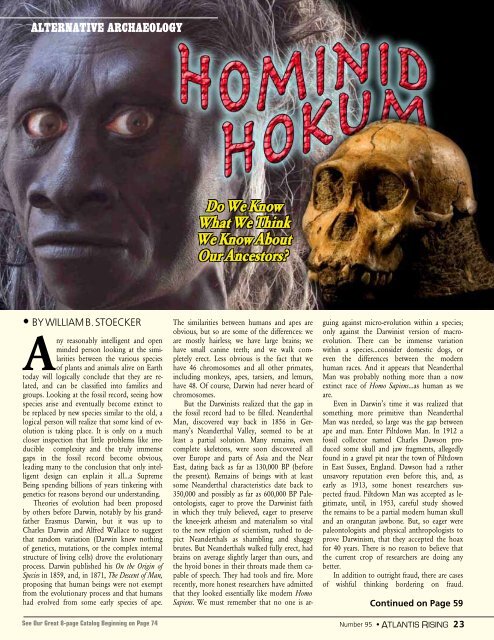Do We Know What We Think We Know About ... - TheUFOStore.com
Do We Know What We Think We Know About ... - TheUFOStore.com
Do We Know What We Think We Know About ... - TheUFOStore.com
Create successful ePaper yourself
Turn your PDF publications into a flip-book with our unique Google optimized e-Paper software.
ALTERNATIVE ARCHAEOLOGY<br />
• BY WILLIAM B. STOECKER<br />
Any reasonably intelligent and open<br />
minded person looking at the similarities<br />
between the various species<br />
of plants and animals alive on Earth<br />
today will logically conclude that they are related,<br />
and can be classified into families and<br />
groups. Looking at the fossil record, seeing how<br />
species arise and eventually be<strong>com</strong>e extinct to<br />
be replaced by new species similar to the old, a<br />
logical person will realize that some kind of evolution<br />
is taking place. It is only on a much<br />
closer inspection that little problems like irreducible<br />
<strong>com</strong>plexity and the truly immense<br />
gaps in the fossil record be<strong>com</strong>e obvious,<br />
leading many to the conclusion that only intelligent<br />
design can explain it all…a Supreme<br />
Being spending billions of years tinkering with<br />
genetics for reasons beyond our understanding.<br />
Theories of evolution had been proposed<br />
by others before Darwin, notably by his grandfather<br />
Erasmus Darwin, but it was up to<br />
Charles Darwin and Alfred Wallace to suggest<br />
that random variation (Darwin knew nothing<br />
of genetics, mutations, or the <strong>com</strong>plex internal<br />
structure of living cells) drove the evolutionary<br />
process. Darwin published his On the Origin of<br />
Species in 1859, and, in 1871, The Descent of Man,<br />
proposing that human beings were not exempt<br />
from the evolutionary process and that humans<br />
had evolved from some early species of ape.<br />
See Our Great 8-page Catalog Beginning on Page 74<br />
<strong>Do</strong> <strong>Do</strong> <strong>Do</strong> <strong>Do</strong> <strong>Do</strong> <strong>Do</strong> <strong>Do</strong> <strong>Do</strong> <strong>Do</strong> <strong>Do</strong> <strong>We</strong> <strong>We</strong> <strong>We</strong> <strong>We</strong> <strong>We</strong> <strong>We</strong> <strong>We</strong> <strong>We</strong> <strong>We</strong> <strong>We</strong> <strong>Know</strong> <strong>Know</strong> <strong>Know</strong> <strong>Know</strong> <strong>Know</strong> <strong>Know</strong> <strong>Know</strong> <strong>Know</strong> <strong>Know</strong> <strong>Know</strong><br />
<strong>What</strong> <strong>What</strong> <strong>What</strong> <strong>What</strong> <strong>What</strong> <strong>What</strong> <strong>What</strong> <strong>What</strong> <strong>What</strong> <strong>What</strong> <strong>We</strong> <strong>We</strong> <strong>We</strong> <strong>We</strong> <strong>We</strong> <strong>We</strong> <strong>We</strong> <strong>We</strong> <strong>We</strong> <strong>We</strong> <strong>Think</strong> <strong>Think</strong> <strong>Think</strong> <strong>Think</strong> <strong>Think</strong> <strong>Think</strong> <strong>Think</strong> <strong>Think</strong> <strong>Think</strong> <strong>Think</strong><br />
<strong>We</strong> <strong>We</strong> <strong>We</strong> <strong>We</strong> <strong>We</strong> <strong>We</strong> <strong>We</strong> <strong>We</strong> <strong>We</strong> <strong>We</strong> <strong>Know</strong> <strong>Know</strong> <strong>Know</strong> <strong>Know</strong> <strong>Know</strong> <strong>Know</strong> <strong>Know</strong> <strong>Know</strong> <strong>Know</strong> <strong>Know</strong> <strong>About</strong><br />
<strong>About</strong> <strong>About</strong> <strong>About</strong> <strong>About</strong><br />
<strong>About</strong><br />
Our Our Our Our Our Our Our Our Our Our Ancestors?<br />
Ancestors? Ancestors? Ancestors? Ancestors?<br />
Ancestors?<br />
The similarities between humans and apes are<br />
obvious, but so are some of the differences: we<br />
are mostly hairless; we have large brains; we<br />
have small canine teeth; and we walk <strong>com</strong>pletely<br />
erect. Less obvious is the fact that we<br />
have 46 chromosomes and all other primates,<br />
including monkeys, apes, tarsiers, and lemurs,<br />
have 48. Of course, Darwin had never heard of<br />
chromosomes.<br />
But the Darwinists realized that the gap in<br />
the fossil record had to be filled. Neanderthal<br />
Man, discovered way back in 1856 in Germany’s<br />
Neanderthal Valley, seemed to be at<br />
least a partial solution. Many remains, even<br />
<strong>com</strong>plete skeletons, were soon discovered all<br />
over Europe and parts of Asia and the Near<br />
East, dating back as far as 130,000 BP (before<br />
the present). Remains of beings with at least<br />
some Neanderthal characteristics date back to<br />
350,000 and possibly as far as 600,000 BP Paleontologists,<br />
eager to prove the Darwinist faith<br />
in which they truly believed, eager to preserve<br />
the knee-jerk atheism and materialism so vital<br />
to the new religion of scientism, rushed to depict<br />
Neanderthals as shambling and shaggy<br />
brutes. But Neanderthals walked fully erect, had<br />
brains on average slightly larger than ours, and<br />
the hyoid bones in their throats made them capable<br />
of speech. They had tools and fire. More<br />
recently, more honest researchers have admitted<br />
that they looked essentially like modern Homo<br />
Sapiens. <strong>We</strong> must remember that no one is ar-<br />
guing against micro-evolution within a species;<br />
only against the Darwinist version of macroevolution.<br />
There can be immense variation<br />
within a species…consider domestic dogs, or<br />
even the differences between the modern<br />
human races. And it appears that Neanderthal<br />
Man was probably nothing more than a now<br />
extinct race of Homo Sapiens…as human as we<br />
are.<br />
Even in Darwin’s time it was realized that<br />
something more primitive than Neanderthal<br />
Man was needed, so large was the gap between<br />
ape and man. Enter Piltdown Man. In 1912 a<br />
fossil collector named Charles Dawson produced<br />
some skull and jaw fragments, allegedly<br />
found in a gravel pit near the town of Piltdown<br />
in East Sussex, England. Dawson had a rather<br />
unsavory reputation even before this, and, as<br />
early as 1913, some honest researchers suspected<br />
fraud. Piltdown Man was accepted as legitimate,<br />
until, in 1953, careful study showed<br />
the remains to be a partial modern human skull<br />
and an orangutan jawbone. But, so eager were<br />
paleontologists and physical anthropologists to<br />
prove Darwinism, that they accepted the hoax<br />
for 40 years. There is no reason to believe that<br />
the current crop of researchers are doing any<br />
better.<br />
In addition to outright fraud, there are cases<br />
of wishful thinking bordering on fraud.<br />
Continued on Page 59<br />
Number 95 • ATLANTIS ATLANTIS RISING RISING 23


